What do you get when you combine the highest mountain on the US East Coast, a 150-year-old railway, and a machine-obsessed toddler? One of the best days ever! Our trip on the Mount Washington Cog Railway was a highlight of our family road trip through New England, and whether you have kids in tow or not, it’s an adventure not to be missed!
What is the Mount Washington Cog Railway?
The Mount Washington Cog Railway is a three-mile rack-and-pinion railway that climbs all the way to the top of the tallest mountain on the United States East Coast. Not only is it incredibly scenic, ascending through the tree line with views of the gorgeous White Mountains all around, but it’s a mechanical marvel and a piece of history. Although you can hike or drive up Mount Washington, there’s no doubt that the railway is the most charming and memorable way to reach the top.
The Mount Washington Cog Railway dates to the late 1860’s and is the second-steepest railway in the world. The average grade is 25%, and there’s one spot where it’s a whopping 37%. In case you, like me, are not an engineer, that essentially means that you gain 37 feet of elevation over a distance of just 100 feet. For comparison’s sake, 6% is the maximum grade allowed on a US highway. It doesn’t take long to gain a few thousand feet in altitude!
And once you’re at the top, the views are impressive. On a clear day at the summit, you can see Vermont, Quebec, Maine, and even the Atlantic Ocean in a single 360-degree turn. Those clear days can be elusive, though; Mount Washington is notorious for bad weather that can change in an instant. But that’s all a part of the adventure!
Our Experience Riding "the Cog"
Of all the things we considered doing on our family road trip to New England, the Mount Washington Cog Railway was the only one we booked in advance. This was the trip we didn’t want to miss.
We rode the Cog on our second full day in North Conway, New Hampshire, loading up the kids in the morning for the 45-minute drive to Marshfield Base Station. The drive alone was worth the time as we passed through the gorgeous White Mountain National Forest. If we had had more time (or older children who didn’t need afternoon naps afterward), I would have loved to pull off at one of the many trailheads and waterfalls to explore the forest. Next time, I suppose!
At last, we turned off of Highway 302 and drove six more miles on Base Station Road to its terminus at Marshfield Base Station. The station is the Cog Railway’s departure point and sits at the bottom of the mountain welcoming visitors with the usual goods: a free museum, gift shop, snack bar, restrooms, and a ticketing office.
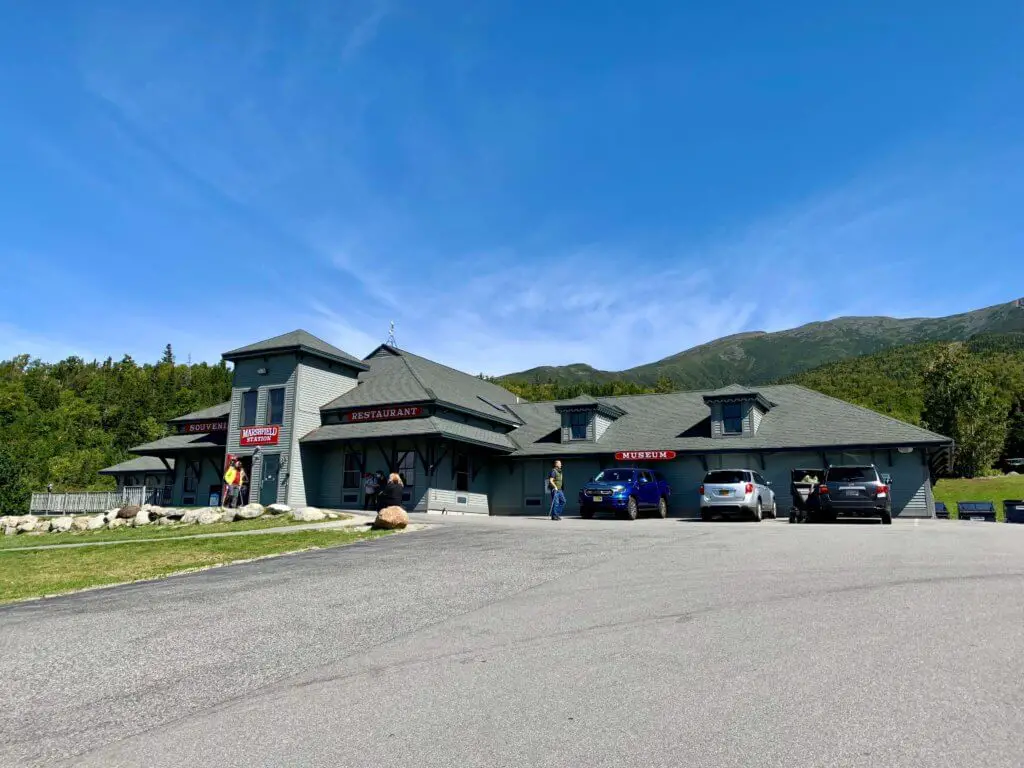
Dirty diapers and the resultant wardrobe changes left us with little time to explore the station upon arrival. Instead, we made our way through the building to the boarding gates.
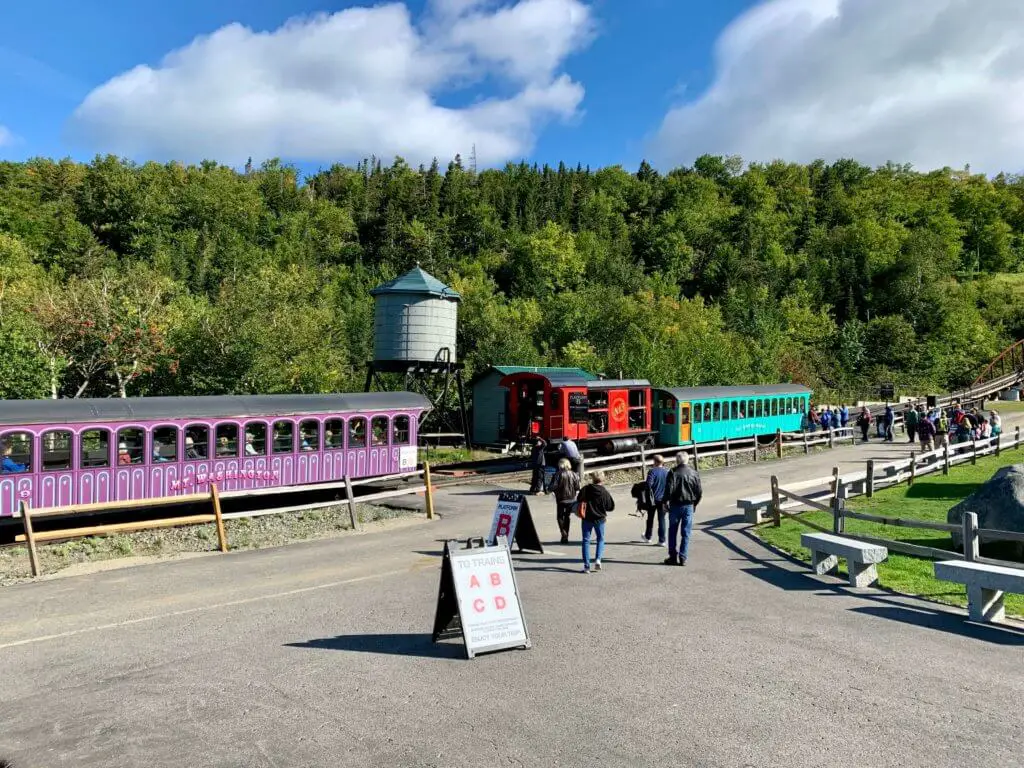
Our tickets were for the B train, and I fortuitously had snagged the first two seats on the left-hand side. We were among the last to board, and it wasn’t long after we were settled with a kid on each lap that the train chugged into motion and began its ascent.
The sky was a bright and brilliant blue, though we knew anything could be waiting for us at the top of the mountain.
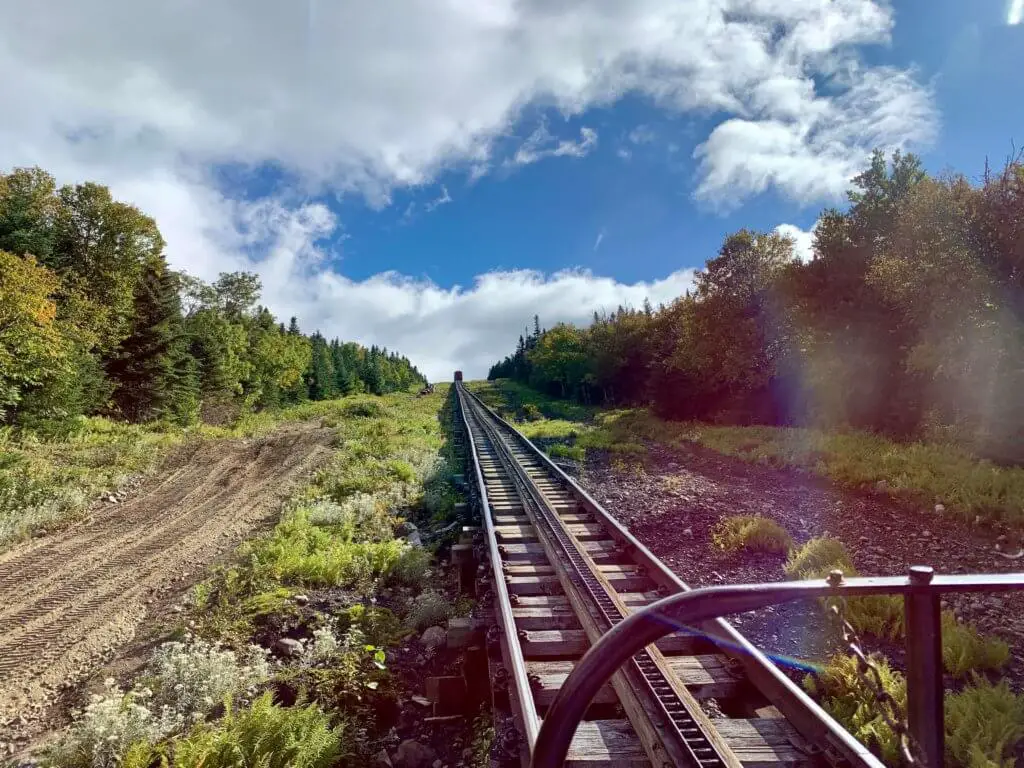
The entire journey was narrated by the brakeman, who not only served as the engineer’s eyes on the tracks but also regaled us with facts and stories from the history of the Cog. He explained how cog wheels rotated beneath the train, catching on the notched rack between the parallel rails and pulling us up the steep incline.
His commentary took a brief pause to help guide us through the switch, which allows trains to pass each other along a single track, before continuing on with gusto!
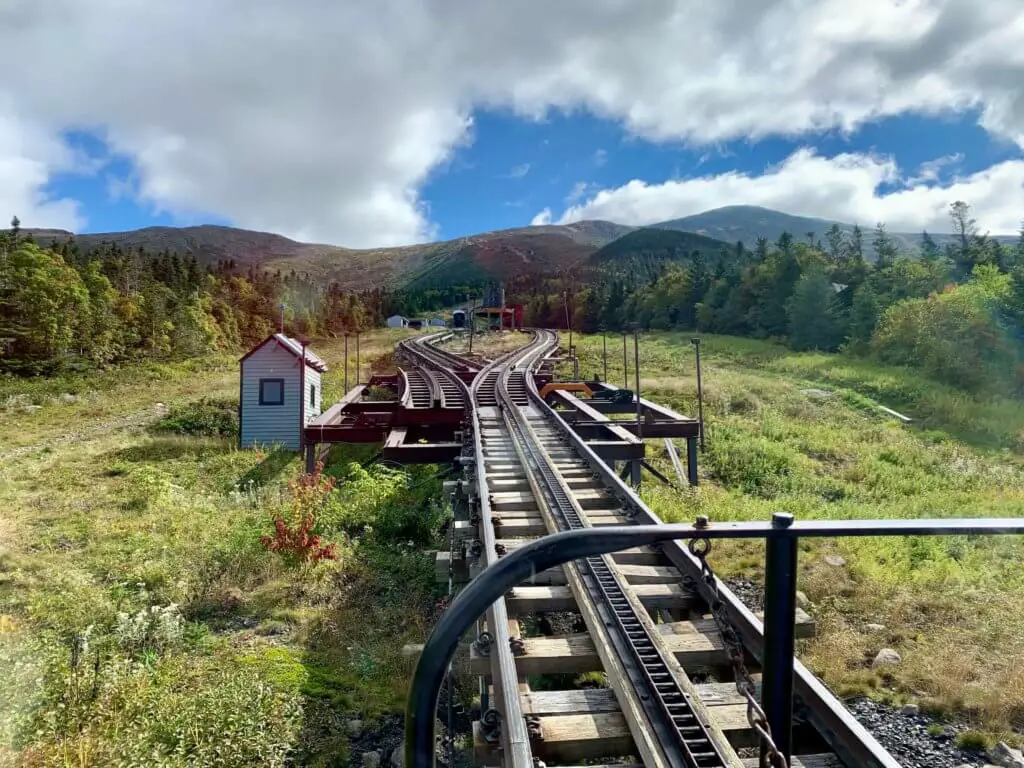
We were rocketing upward at a speed of almost three miles per hour (we would go nearly five on the way down – hold on to your hats!), so there was plenty of time to admire the scenery. It was such a beautiful ride, with the gold of autumn just beginning to touch the trees and a bright blue sky peeking through the clouds.
As we ascended those same clouds grew thicker and more ominous, making me question how pleasant the weather would be at the summit. In the meantime, however, there was nothing to be done but sit back and enjoy as we rumbled over trestles and through the piney forest.
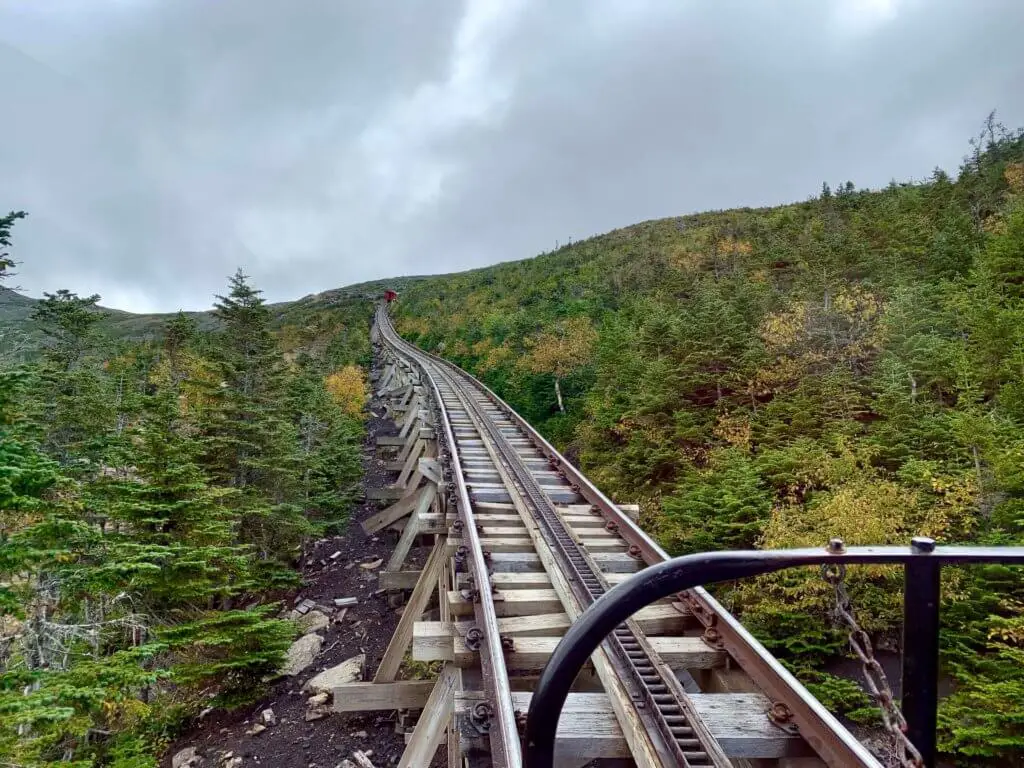
Emerging above the tree line, the steepness of the grade became glaringly obvious. We had felt ourselves being pulled upward, obviously, but it wasn’t until we could see out to the horizon that we realized just how sharp the angle was.
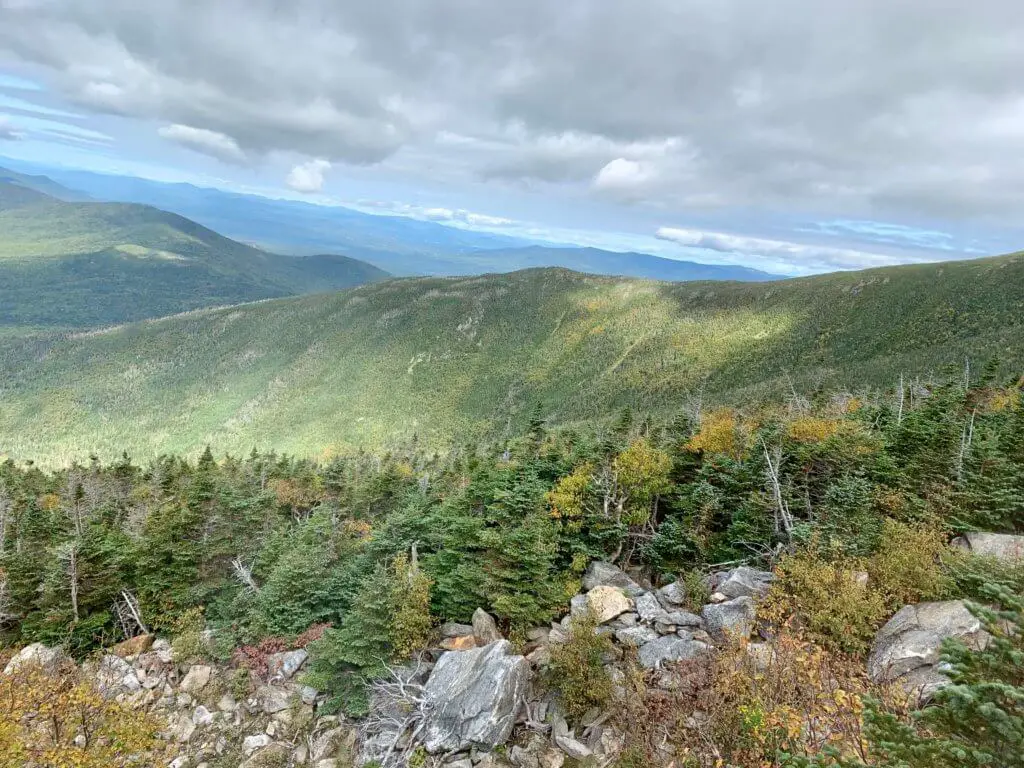
In fact, here’s a side-by-side from one of the steeper parts of the trip. I shot the first photo holding my camera perfectly horizontal out the window, while the second corrects the horizon line to where it should have been:
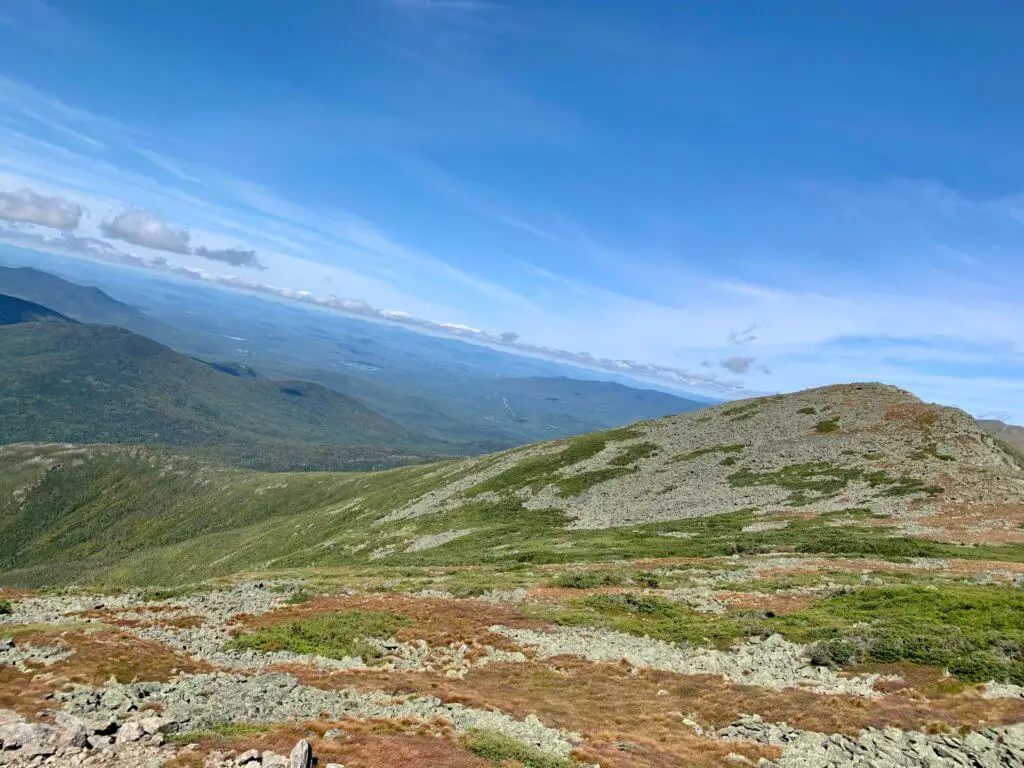
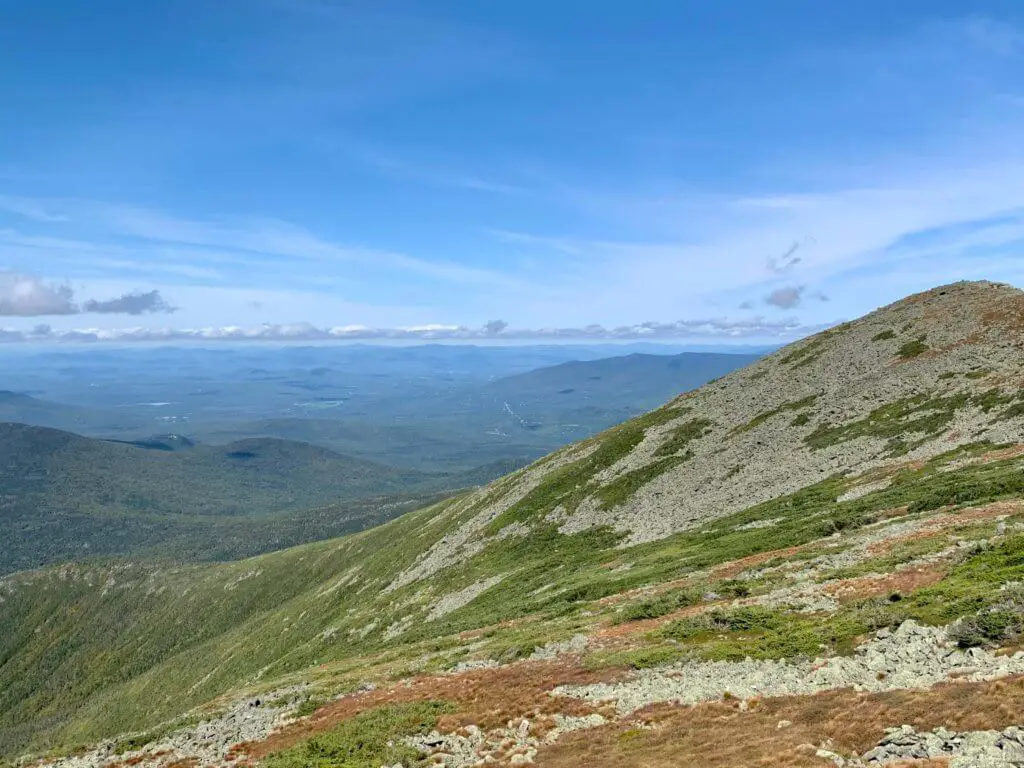
And still, we kept climbing. Up here it was rocky and windswept, with hardy vegetation tenaciously clinging to life in an unforgiving environment. The train in front of us looked smaller and lonelier as we went along.
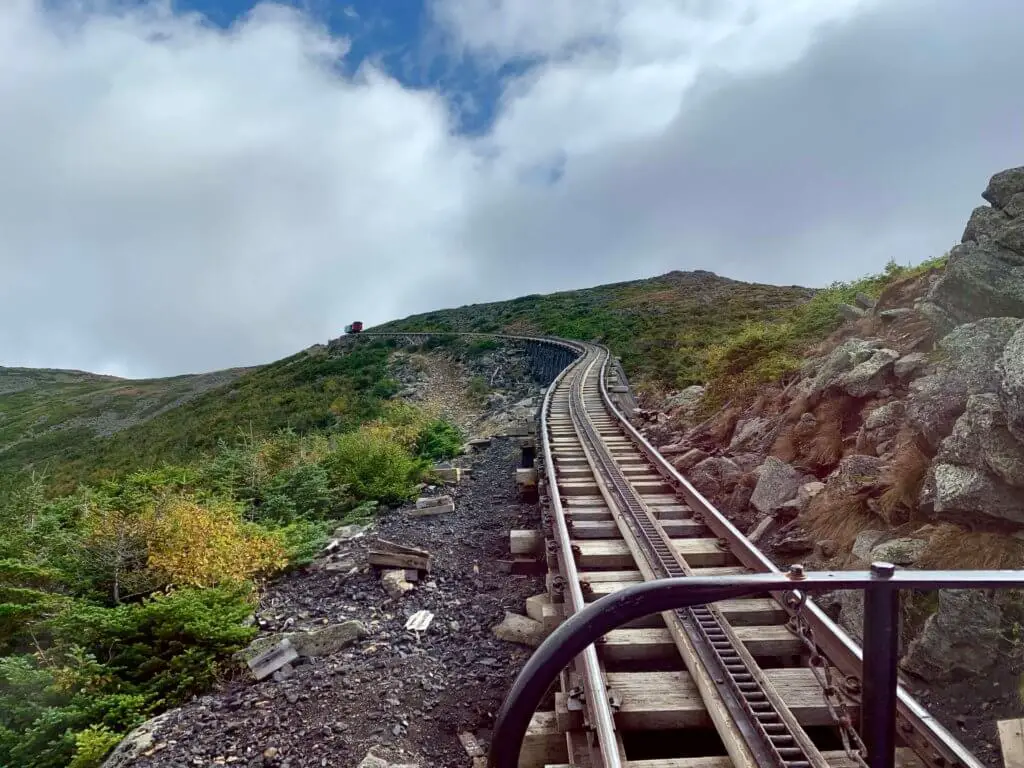
When you turned around, however, the views were stunning. The trees had fallen away to reveal green mountains rolling off into the distance. They stretched all the way into Vermont and Quebec before disappearing into that wonky horizon.
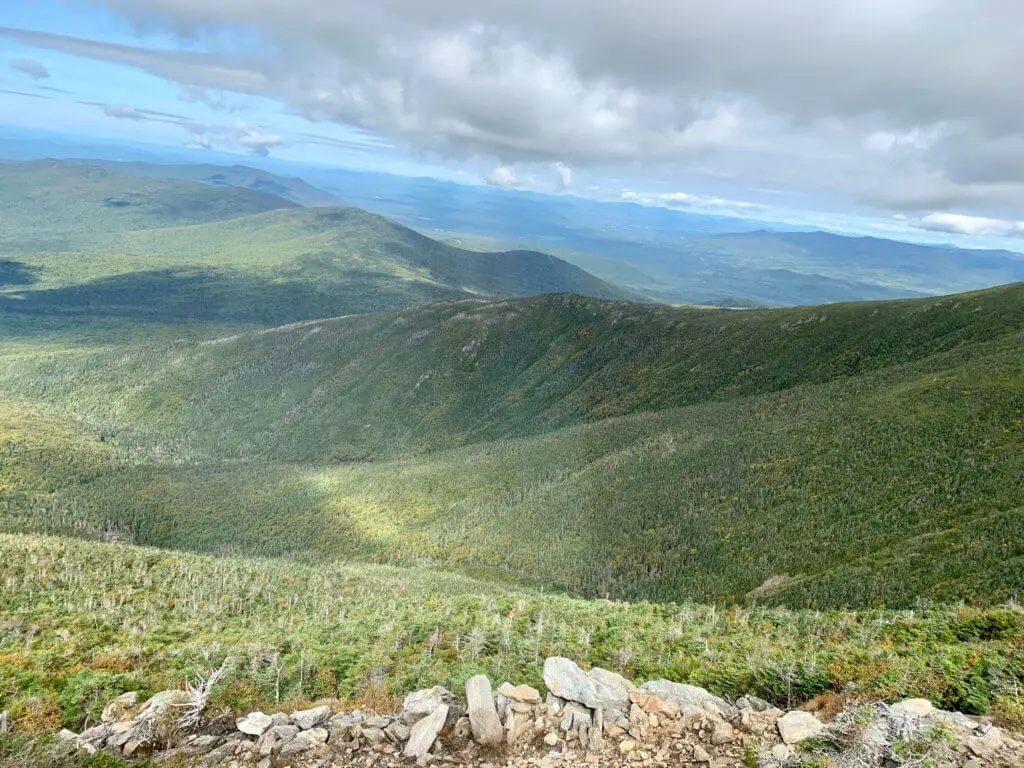
And then, after a little less than an hour, we made it to the top of the mountain. It’s actually a state park up there! I’m not sure what I was expecting – perhaps a viewing platform and a small building with services – but it’s actually a pretty big operation. There’s a visitor’s center with a cafeteria and (shocker!) gift shop, a research observatory, and a museum, in addition to an extensive viewing area and good-sized parking lot for the folks who choose to drive to the summit.
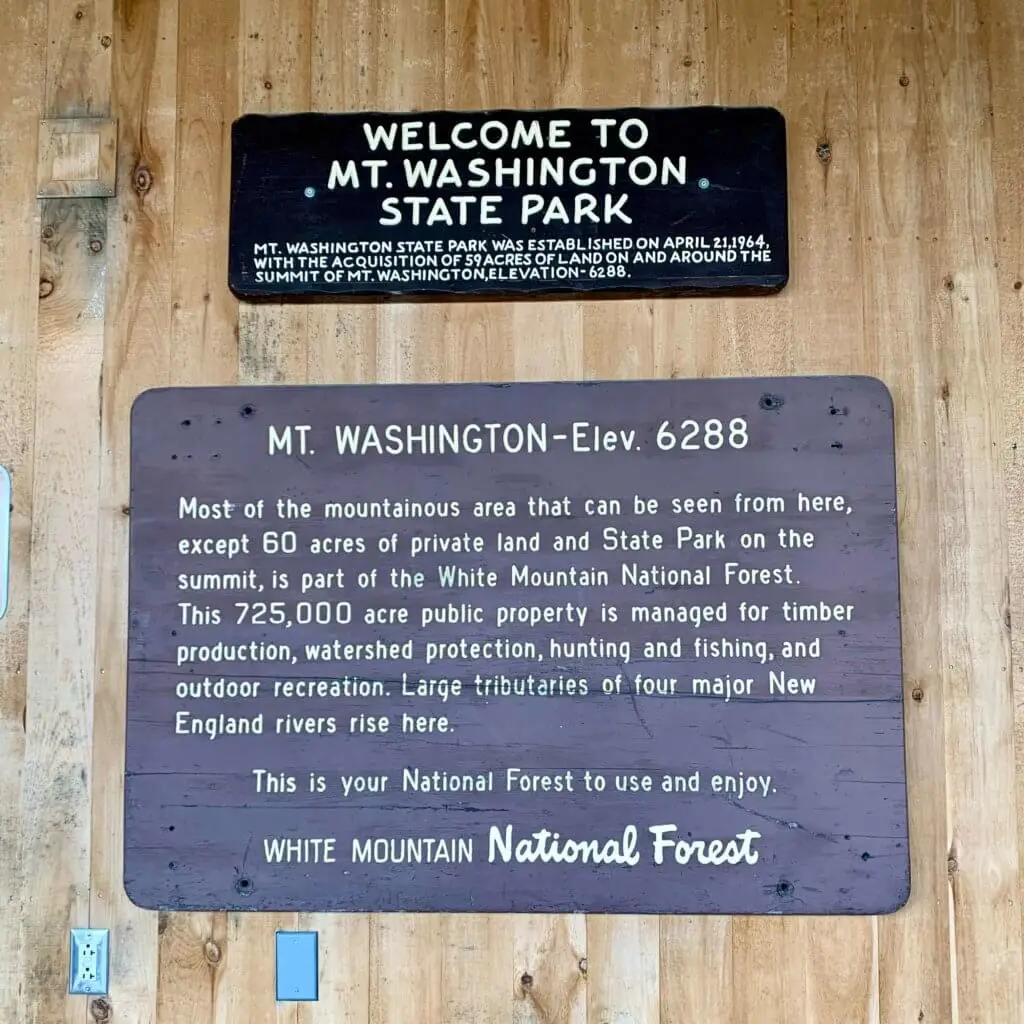
Our train came to a stop and we emerged into a chilly fog. This wasn’t unusual; the summit of Mount Washington is notorious for terrible weather, and especially for wind. The highest wind speed on Earth – a whopping 231 miles per hour – was recorded here in 1934. I knew when we booked the trip that it was likely that we wouldn’t be able to see much from the top, and for a few minutes, I was right. We made our way through the visitor’s center to the viewing platform and stared out into the clouds.
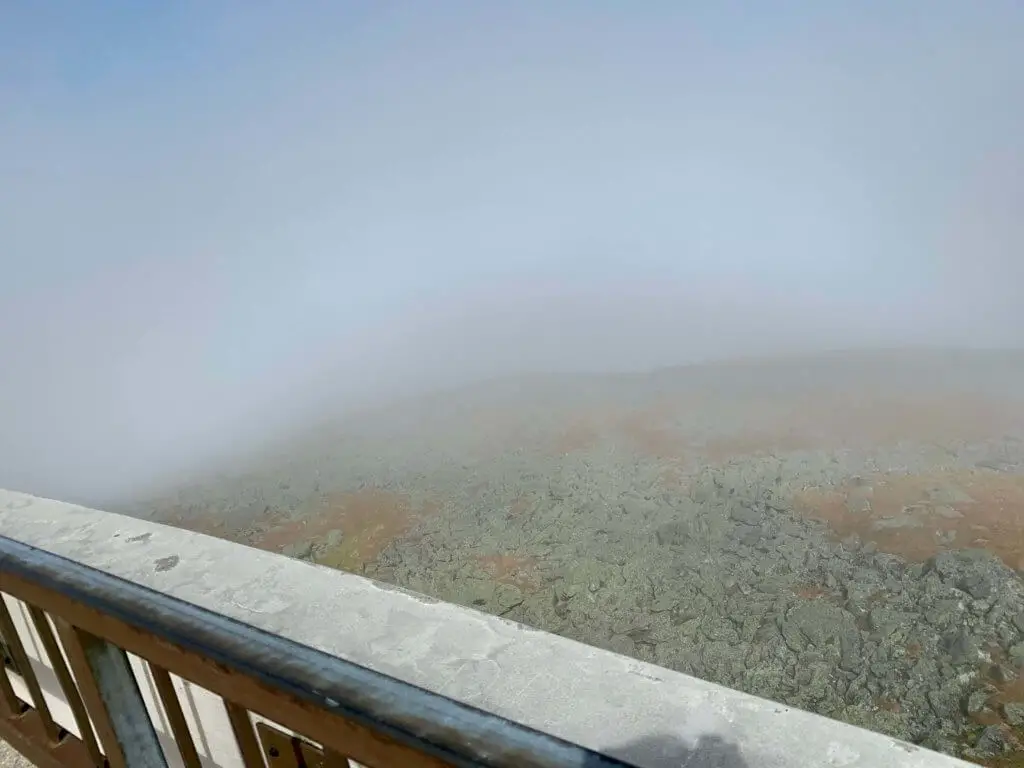
But miraculously, within moments Mount Washington’s fickle weather began to work in our favor. The clouds began to dissipate, revealing that blue sky into which we had begun our adventure. Suddenly, I could make out one of the trains making its lonely way back down the mountain.
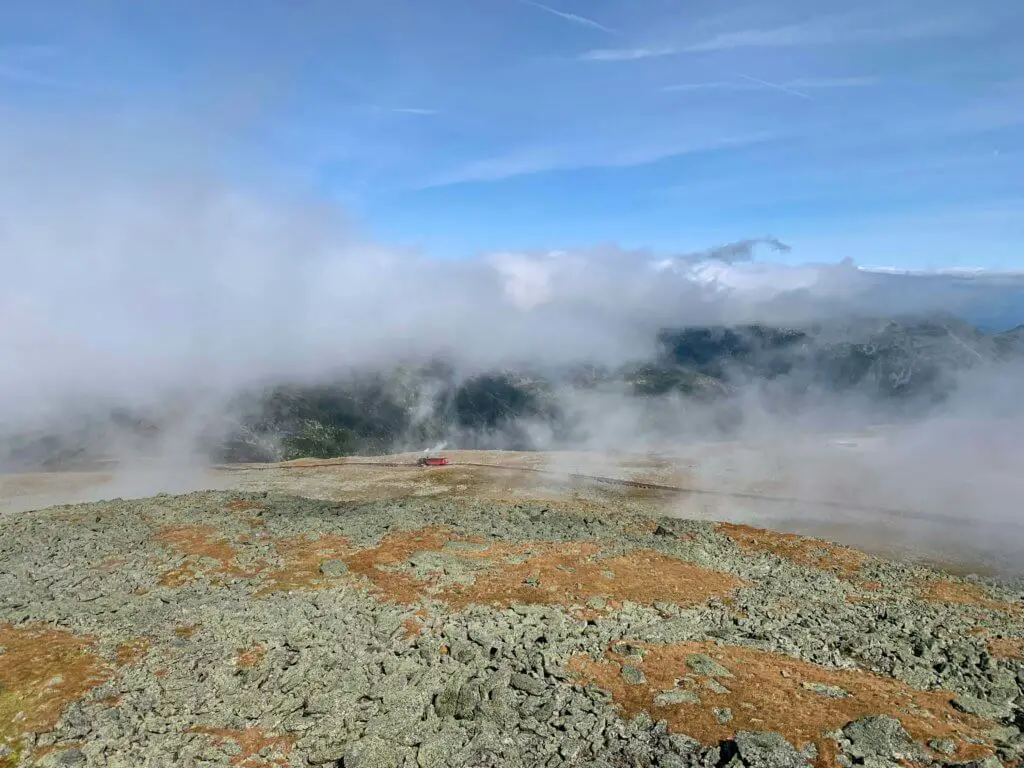
We got our first real glimpses of the observatory and the actual summit…
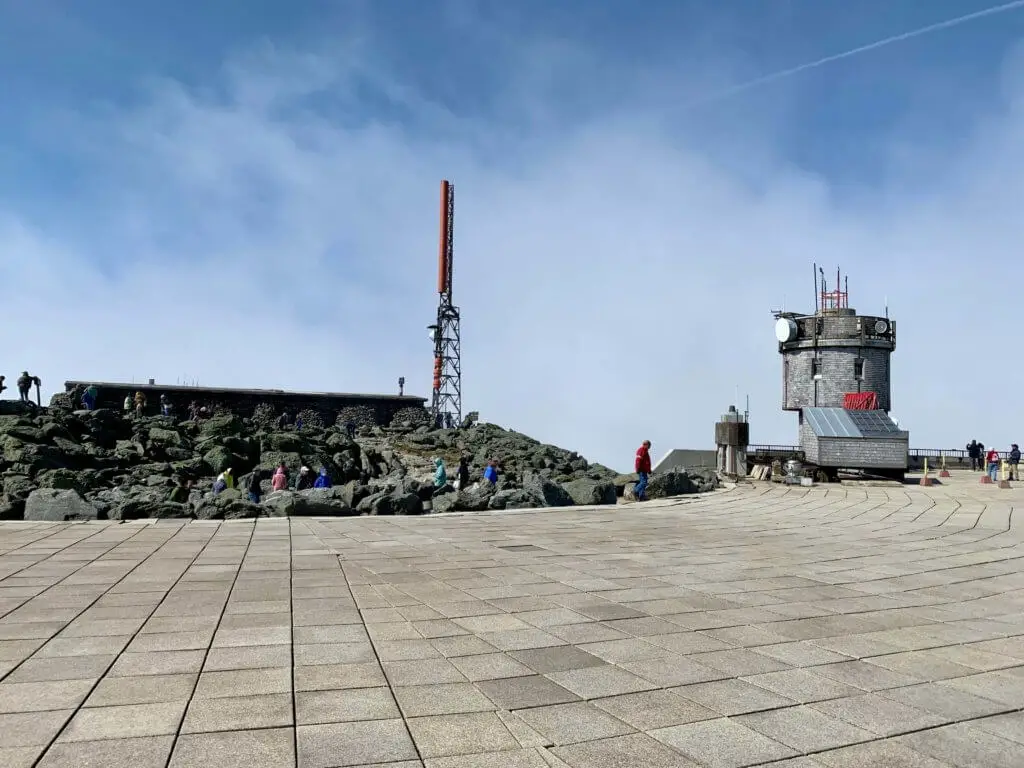
… as well as the mountains that surrounded us in all directions.
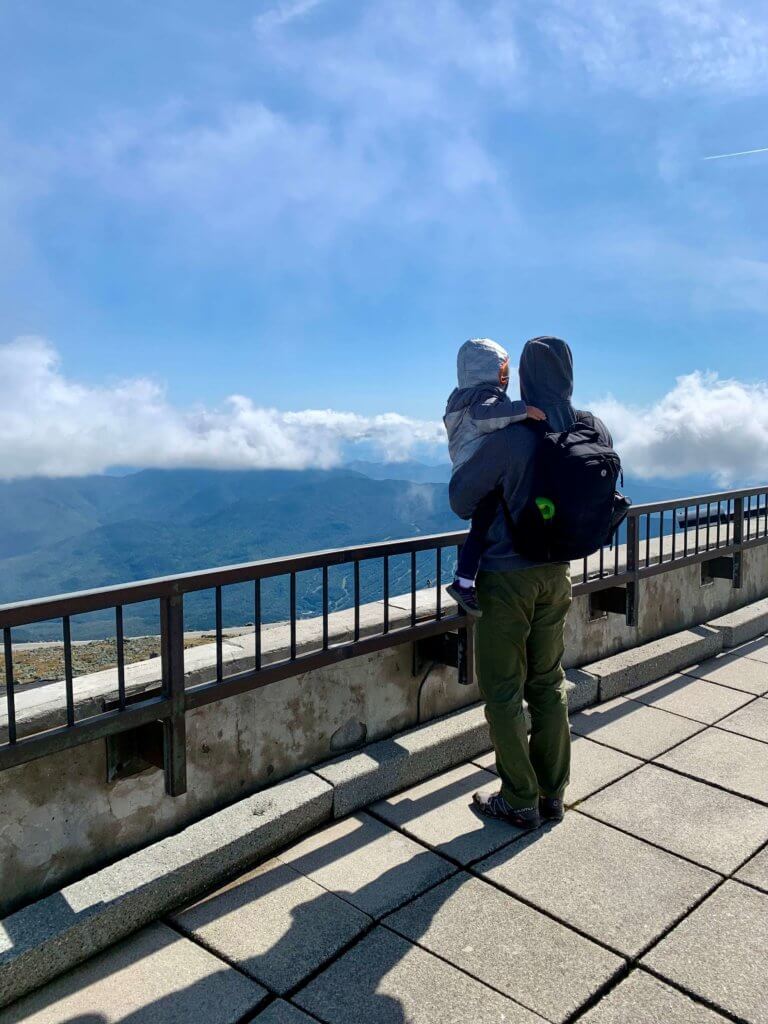
We spent some time wandering the grounds, admiring the views and posing for the obligatory family photo at the summit. (Well, three of us, anyway; S had fallen asleep in the baby carrier on the way up, so she was hidden in my jacket. I didn’t want to disturb her to put on her own coat.)
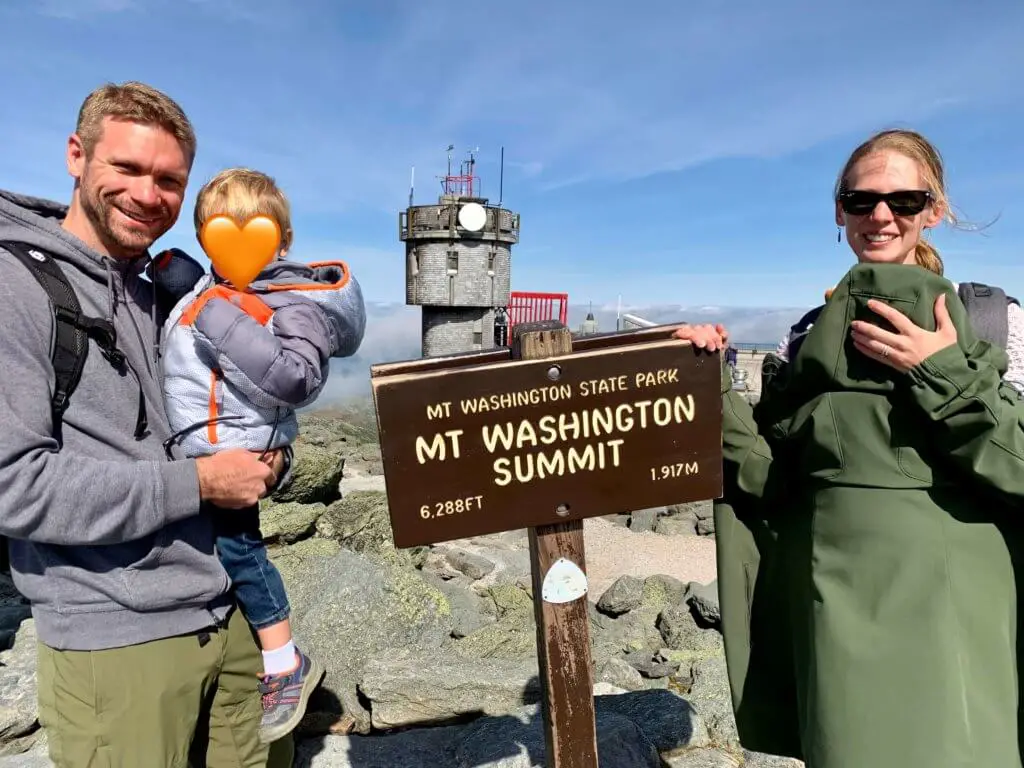
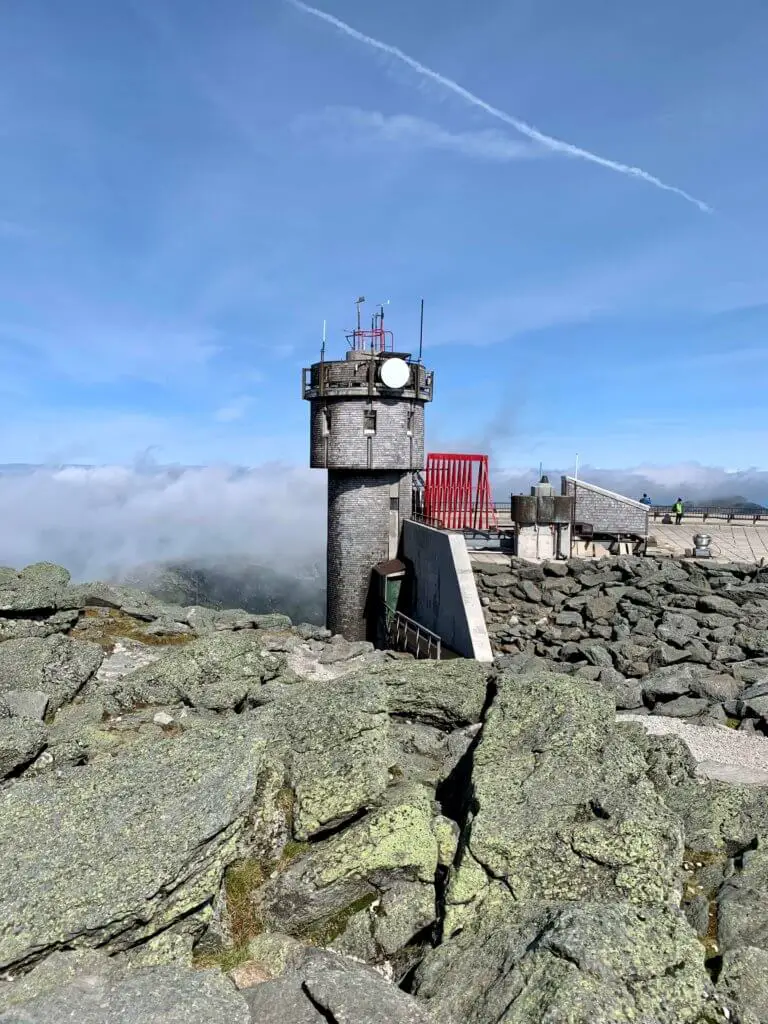
Moving eastward, we could see the large auto road parking lot looking out over eastern New Hampshire and Maine, with the Atlantic Ocean just visible on the horizon.
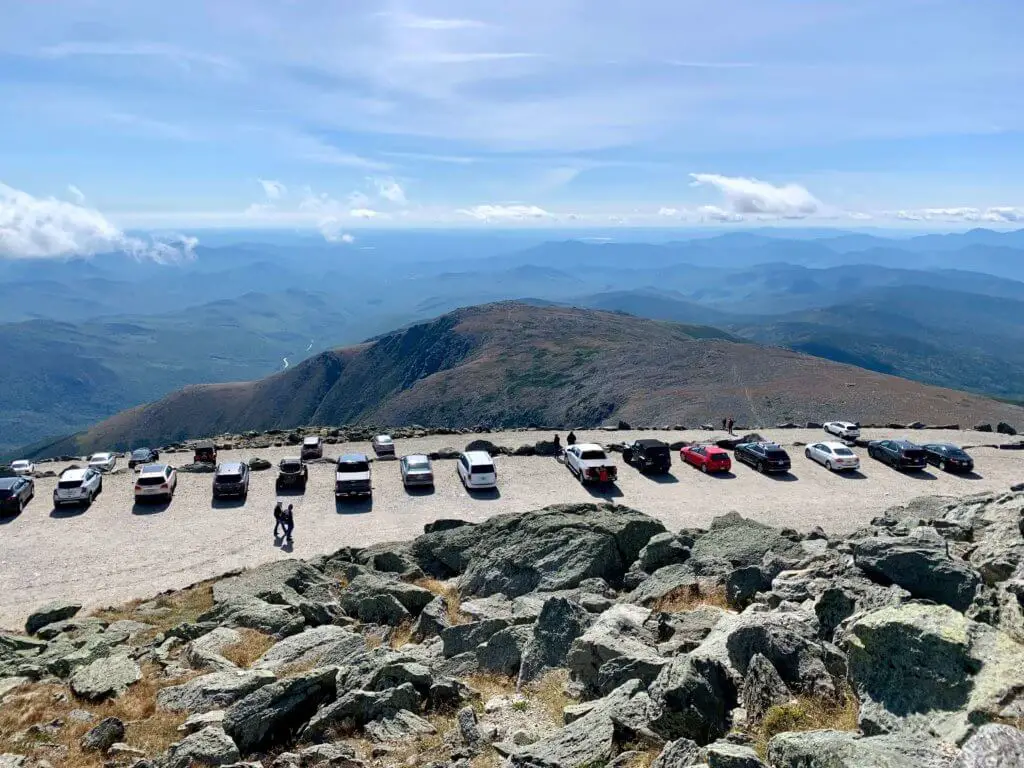
It was chilly, but it had truly turned into a beautiful day. Had we not had a toddler in need of a snack and a warm-up, M and I probably would have done a lot more exploring. Instead, we spent some time inside the visitor’s center escaping the chill and scarfing down some snacks.
It was so gorgeous, however, that we couldn’t stay inside for long. We soon returned to the outdoor viewing area to admire the scenery for as long as possible before our train arrived to collect us.
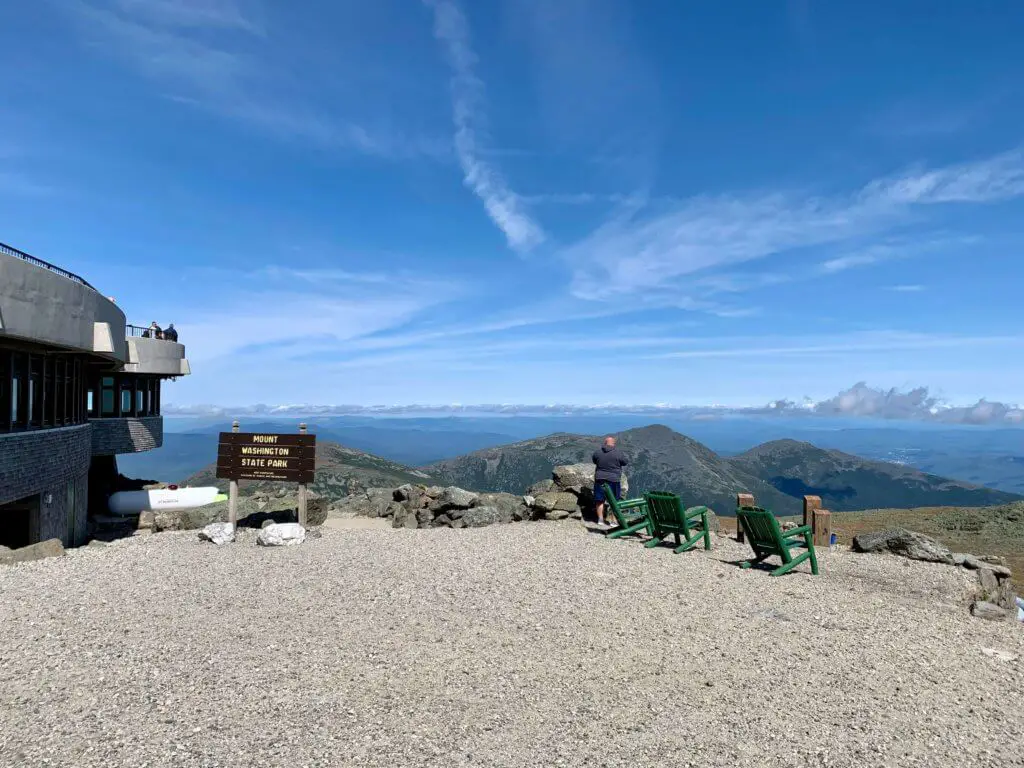
After a quick hour, our return trains chugged into the summit station and we boarded our car for the ride back down the mountain.
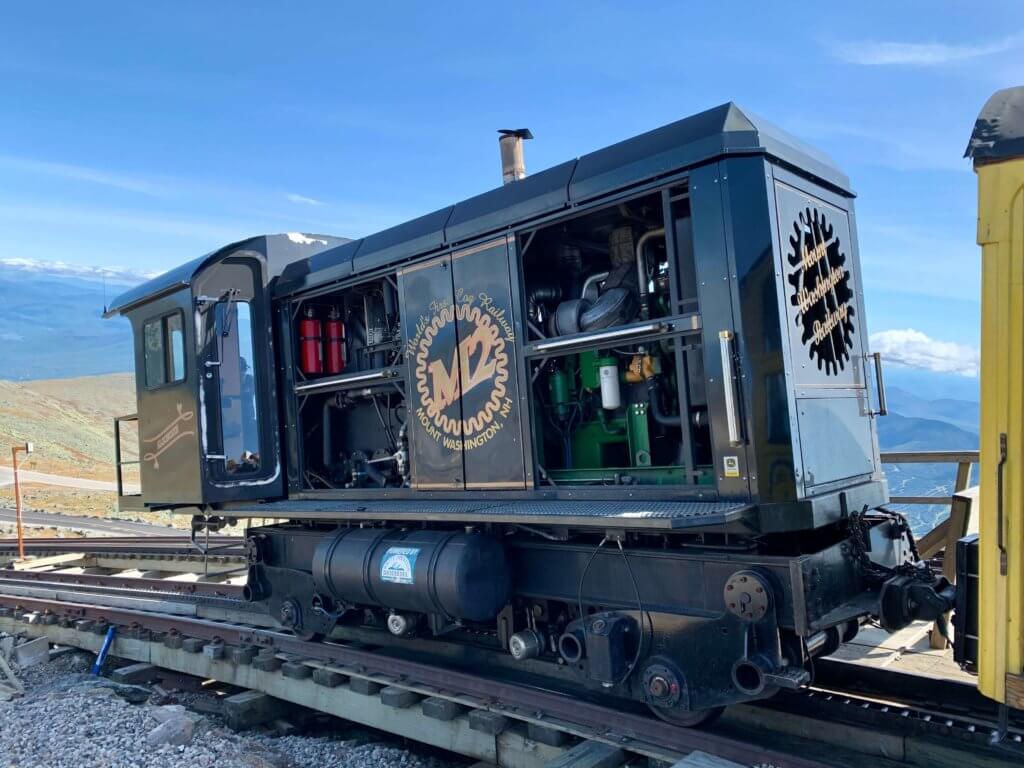
While the engine had pushed us up the mountain on the way to the summit, all of the seats had been turned around for the return trip and the engine went before us. Our front-row seats were now the last in the car, but we didn’t mind in the least. The views out the windows were still great and, to be honest, I really didn’t need to see how steep the drop was in front of us anyway!
Our new brakeman shared some more stories about Mount Washington and the Cog Railway on the way down, including tales of “Devil’s Shingles.” Basically, in the early days of the railroad, workers would hop onto a wooden plank and slide down the center racks to the bottom, doing so at breakneck (often literally) speed. Like, sixty miles per hour speed.
No, thank you!
We, on the other hand, made it safely to the bottom. There, E spent a few minutes checking out the historic engines on display, and we actually got a chance to peruse the gift shop and museum.
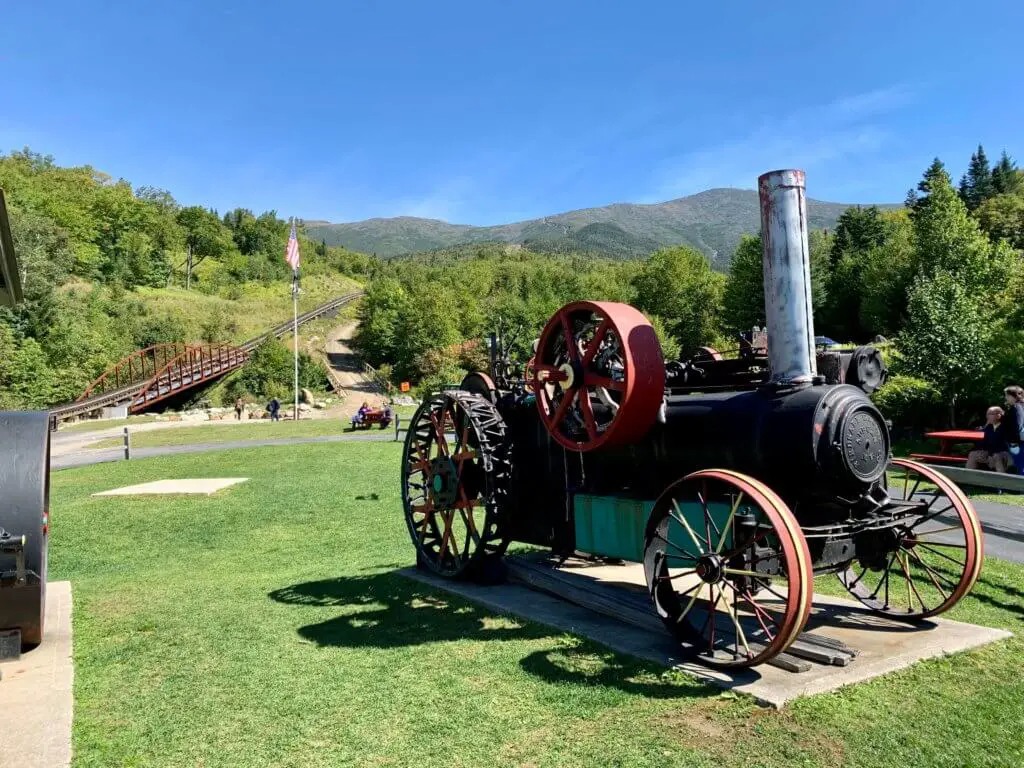
By that time, however, all of us were pretty famished, so we didn’t linger long. Even so, the Mount Washington Cog Railway was an absolute highlight of our family trip to New England. The wonder on E’s face as we clickety-clacked our way up the mountain, the feeling of exhilaration as the clouds parted at the summit to reveal miles of gorgeous scenery, and the charm of riding a piece of history are all memories we’ll cherish for a lifetime. If you’re in the neighborhood of Mount Washington – and especially if you have children or are a kid at heart – I strongly encourage you to consider taking your own ride on the Cog.
Cog Railway Tips and FAQ's
How much does it cost to ride the Cog Railway?
At the time of writing, it costs $72 per adult, $49 per child, and $68 for senior citizens (65+) to ride the Cog Railway to the summit. Children age four and under ride for free on a parent’s lap.
It is essential that you reserve your seats in advance. The railway is very popular, and tickets do sell out.
Should we ride the steam or biodiesel train on the Mount Washington Cog Railway?
There are two kinds of engines that make the trip up Mount Washington: biodiesel and steam. Historical purists should choose the coal-powered steam engines, as they date to 1875 and 1908. The steam engines are slower and have to stop once en route to take on more water. They also emit more smoke, so anyone sensitive to the sight or smell of smoke should go the biodiesel route.
The modern biodiesel engines are quieter, faster, and more environmentally friendly. There are also more biodiesel departures available. We chose the biodiesel because it worked best for our schedule, but I also think the lack of smoke and quieter ride was probably the best for our children’s ages.
What are the best seats on the Mount Washington Cog Railway?
I recommend choosing seats in the first row of the train, which gives you an unobstructed view going up the mountain. The trains descend in the opposite direction, though, so Row 1 is at the very back on the way down. If you don’t like this extreme (I didn’t mind because I didn’t exactly want a good view of the steep hill below us!), choose a seat toward the middle. Especially on the steam train, it may be a bit noisier in the back (going up-mountain, the front going down) because you’re closer to the engine.
The train on Platform A will go first, so if you want a train-free view on your ascent you should aim for that one. Our train was second, from Platform B, and I actually liked having the A train a little ways ahead to provide some perspective and fun photos. I also think the view from the left side of the train (facing up-mountain) was probably the best.
What should I wear to ride the Cog Railway?
Regardless of the weather down below, it is absolutely essential to bring warm clothes for the summit. I’m talking winter coats, hats, gloves, the whole shebang. On a mountain famous for wind and weather, it’s better to have some extra layers and not need them than vice versa!
You should also wear sturdy footwear, as there is a lot of uneven ground to traverse at the top of the mountain.
Other Tips for Riding the Cog
- Make sure that you put the correct address in your GPS (168 Base Station Road, Mount Washington, NH 03589), as the auto road is a full hour away on the other side of the mountain. If you accidentally head to that starting point, you’ll never make your train.
- Plan to arrive at least forty-five minutes before your train departs. You’ll want to make sure you have time to find parking, hit the restroom (there are no bathrooms on the trains!), and grab a snack, if needed. Any extra time can be spent checking out the museum or the gift shop or strolling the grounds.
- Watch the clock! The return trains depart promptly, and if you miss yours there’s no guarantee that there will be space for you on a later train.
- Although there are cafeterias at both the base and summit, you can save some money by packing your own snacks and water. That said, it might be worth it to indulge in some hot chocolate or warm soup at the top!
- You can book tickets or find more information about the Mount Washington Cog Railway on their official website.
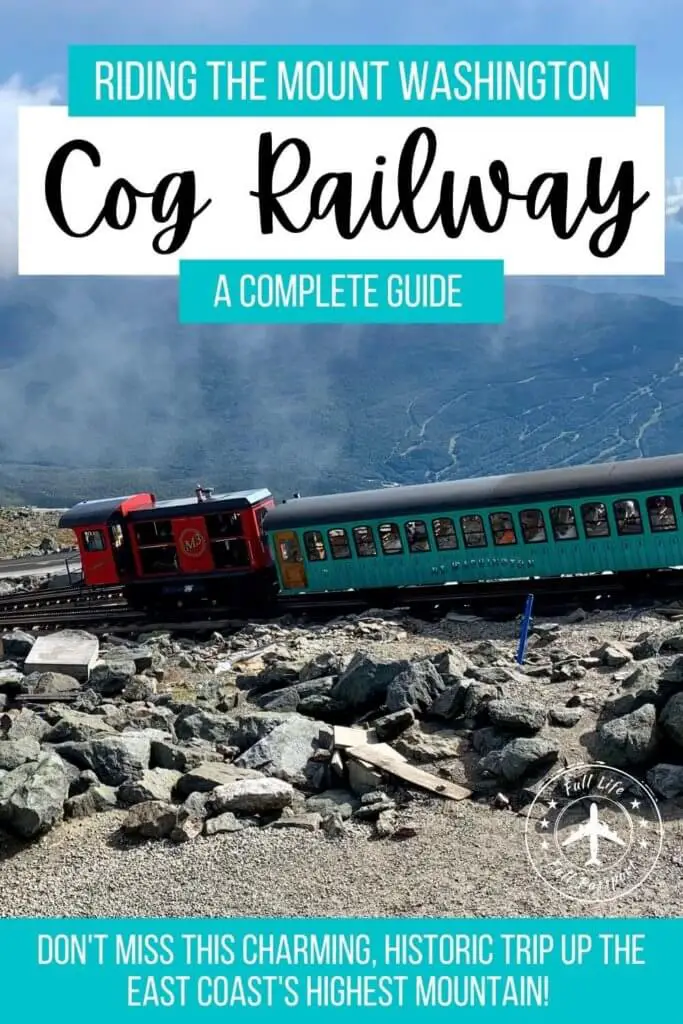
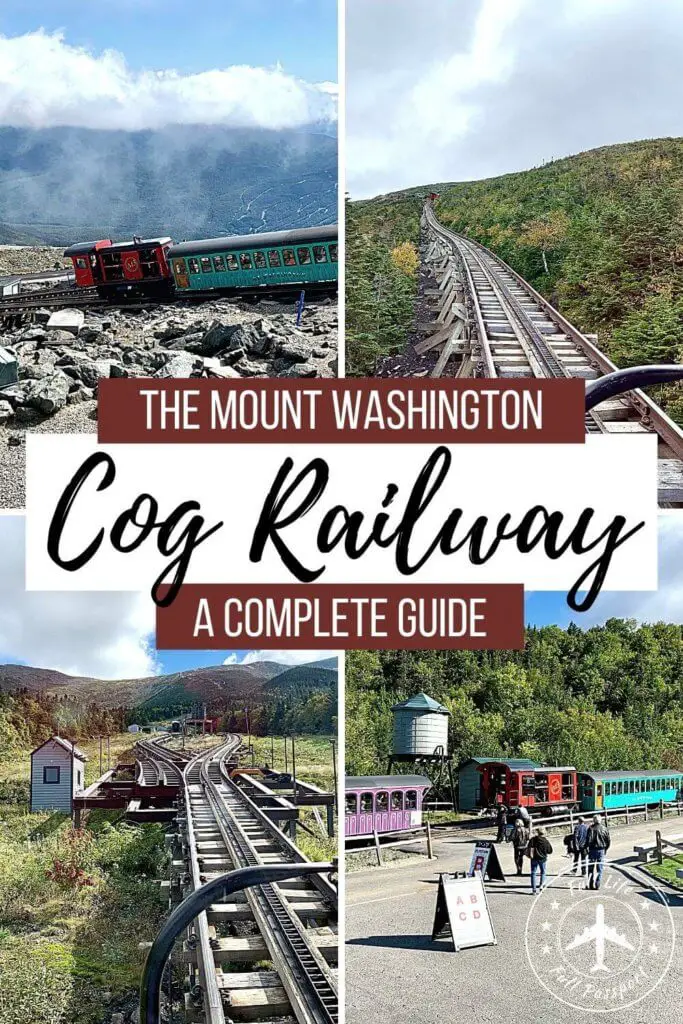
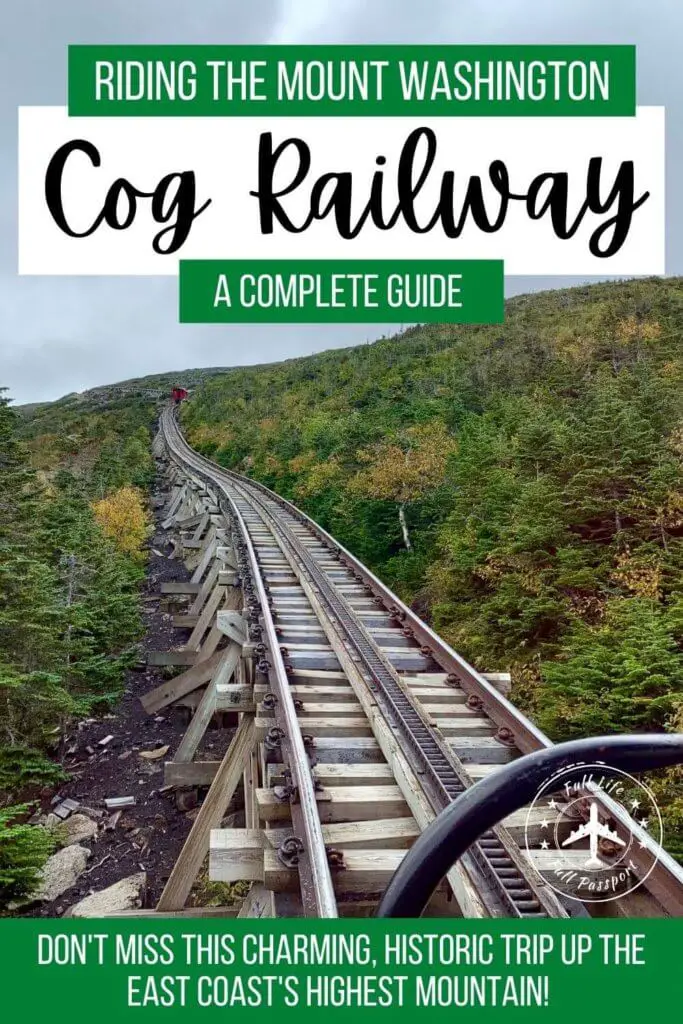
Like the post? Pin to save or share!
Read More:
Need some help planning your trip to New Hampshire? Full Life, Full Passport offers customized planning services for all kinds of vacations and budgets!
Want to be the first to know when a new post is published, or to receive exclusive content directly to your inbox? Join our email list!
There aren’t many places to eat around the Mount Washington Cog Railway
Lorem ipsum dolor sit amet, consectetur adipiscing elit. Ut elit tellus, luctus nec ullamcorper mattis, pulvinar dapibus leo.
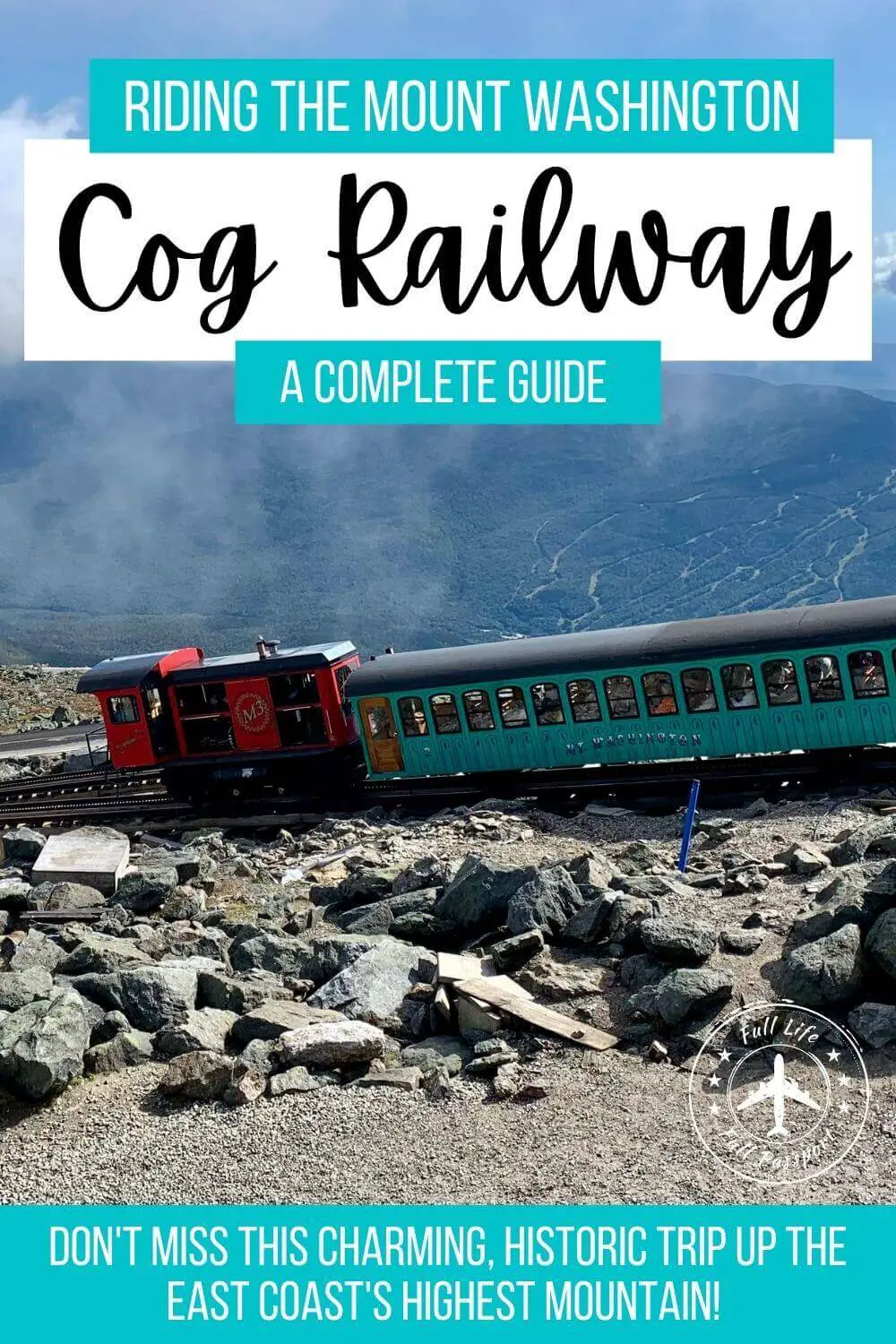
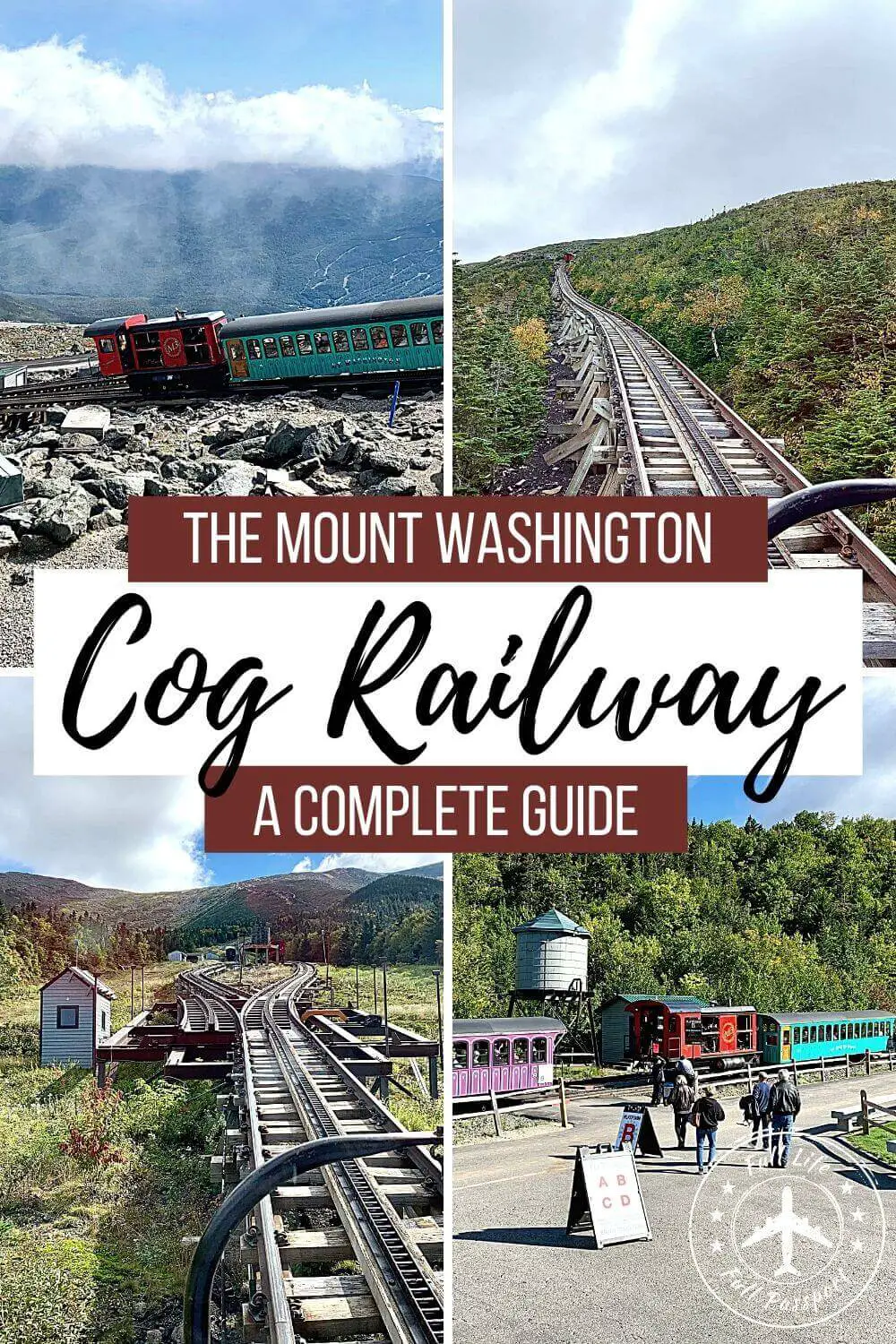
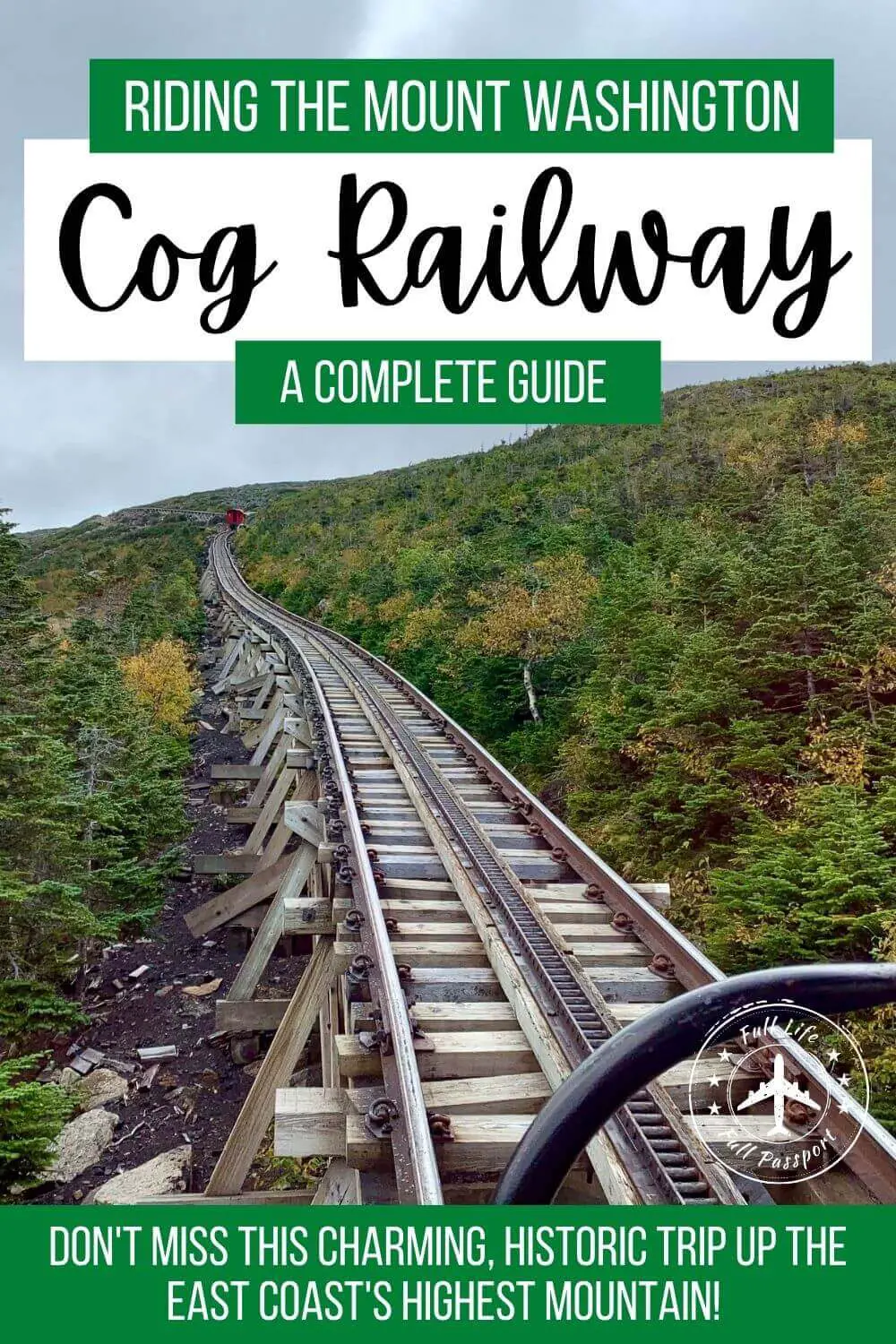

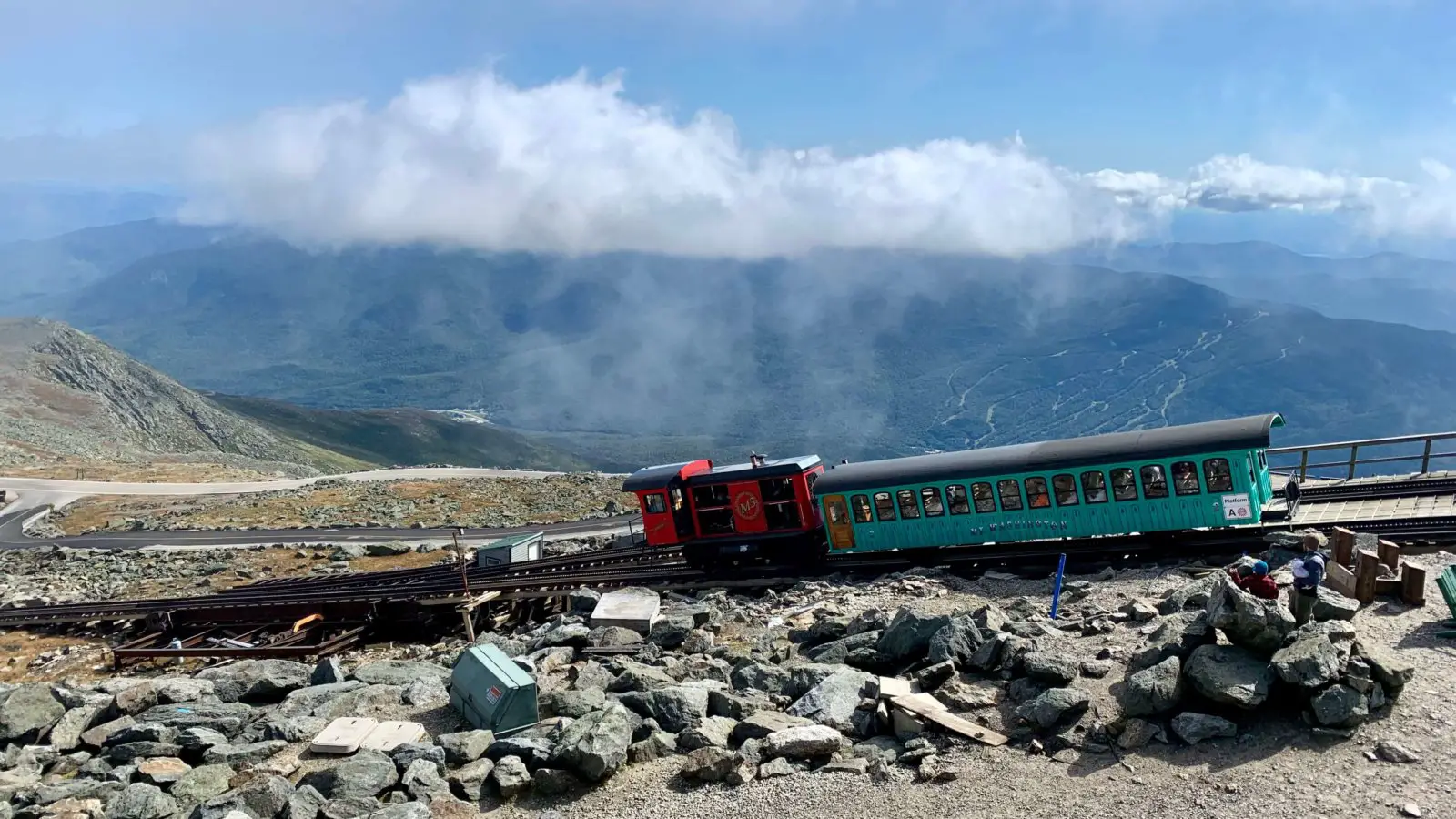
 2021 FLFP Year in Review
2021 FLFP Year in Review

This was amazingly helpful!
Thanks, Callie! Glad to help. Hope you have a great time!